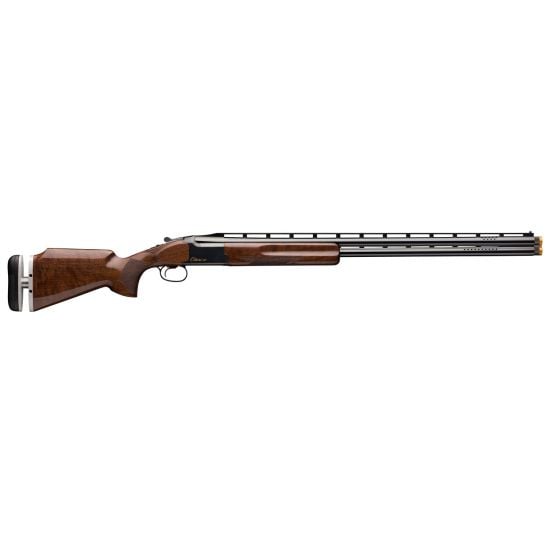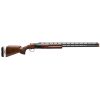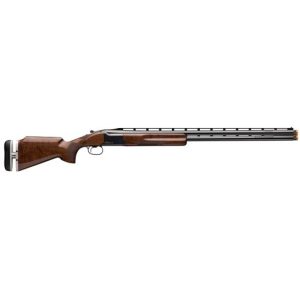Browning Citori CXT Micro Adjustable LOP 12 Gauge Over/Under-Action Shotgun, Gloss – 018164326 For Sale
$2,356.03
The Browning Citori CXT Micro Adjustable LOP 12 Gauge Over/Under-Action Shotgun is a high-performance firearm that marries elegance with functionality. It features a precise wood-to-metal fit, ensuring exceptional durability through expertly machined and heat-treated action components. Designed for versatility, this shotgun excels in trap shooting with a 70/30 point of impact and a wide floating rib with ivory bead and mid-bead for accurate targeting. A highlight is its adjustable Graco butt pad plate, allowing customization of length of pull and toe positioning, coupled with a stylish grade II American walnut Monte Carlo stock with an Inflex 2 recoil pad for reduced felt recoil. It includes three deluxe extended Midas Grade choke tubes for varied shot patterns. Combining traditional craftsmanship with modern adjustability, the CXT Micro Adjustable LOP is ideal for shooters seeking a reliable and precise over/under-action shotgun.
Is the Browning Citori worth the money?
The worth of the Browning Citori largely depends on individual preferences and needs. The Citori is known for its craftsmanship, reliability, and performance, making it a popular choice among hunters and sport shooters. It often has features like excellent balance, ease of handling, and a polished finish. However, it can be expensive compared to other shotguns. If you value high-quality construction and are willing to invest in a long-lasting shotgun, many users find it worth the money. Conversely, if budget constraints are a primary concern, there might be more affordable options that meet your needs.
What is the difference between Browning CX and CXT?
The primary difference between the Browning CX and CXT shotguns lies in their design and intended use. The Browning CX, which stands for “Crossover,” is designed for versatility and can be used effectively for both clay target shooting and hunting. It typically comes with features that accommodate various shooting conditions.
The Browning CXT, on the other hand, stands for “Clay Target Extreme” and is specifically designed for clay target sports, such as trap shooting. It often features specialized components, like a higher rib and specific weight distribution, to improve performance in competitive clay shooting environments.
Overall, the CX offers more of a multi-purpose design, while the CXT focuses on optimizing features for dedicated clay target shooting.
What is the difference between Citori and Citori 725?
The Browning Citori and Citori 725 are both series of over-and-under shotguns, but there are several differences between them:
1. **Design and Aesthetics**: While both models share the Citori name and are known for their craftsmanship, the Citori 725 tends to have modernized aesthetics and design enhancements compared to the more traditional Citori models.
2. **Weight and Handling**: The Citori 725 is often designed to be slightly lighter and has modifications that may enhance balance and handling, catering to a modern shooter’s preferences.
3. **Trigger System**: One of the most notable differences is the trigger system. The Citori 725 typically features the Fire Lite Mechanical Trigger System, which provides a lighter and more responsive trigger pull compared to the inertia-based triggers found in older Citori models.
4. **Invector-DS Choke System**: The Citori 725 generally comes equipped with the Invector-DS choke system, which offers improved patterning and easier adjustment compared to the conventional Invector or Invector-Plus systems found on other Citori models.
5. **Back-Bored Barrels**: The barrels on the Citori 725 are often back-bored to improve shot pattern quality and reduce recoil, a feature that may not be standard on all Citori models.
6. **Recoil Pad Technology**: The Citori 725 may come with an advanced recoil pad, like the Inflex II technology, designed to reduce felt recoil and improve shooting comfort.
In summary, while both the Citori and Citori 725 maintain elements of quality and tradition, the 725 model incorporates modern features and refinements to enhance performance and shooter experience.
What is a used Browning Citori worth?
The value of a used Browning Citori can vary widely based on factors such as the model, condition, age, and any special features or engravings. Generally, prices can range from around $1,000 to over $3,000. For a more precise valuation, it would be best to check online marketplaces, auction sites, or speak with a firearms dealer who can provide an assessment based on the specific details of the Citori in question.
What are the grade levels of Browning Citori?
The Browning Citori shotgun is available in several grade levels, each with varying features, finishes, and embellishments. The main grade levels include:
1. **Grade I**: The standard model with basic finishes and features.
2. **Grade II**: This version often comes with upgraded wood and additional engraving.
3. **Grade III**: Features more detailed engravings and higher quality wood.
4. **Hunter Grade**: Designed specifically for hunters, often with features suited for the field.
5. **White Lightning**: Known for its silver-colored receiver.
6. **Feather**: A lightweight version designed for ease of carry.
7. **525, 625, 725**: These are models which might have variations in mechanics or finishes within the Citori line.
Furthermore, Browning often releases special editions or custom shop grades with unique features or limited availability.
What is the meaning of Citori?
Citori is a name associated with a line of over-under double-barreled shotguns manufactured by Browning Arms Company. The Browning Citori is known for its high-quality craftsmanship, durability, and performance, and it is often used in hunting and sport shooting. The name “Citori” itself does not have a specific meaning beyond its association with this particular product line.
What does CXT stand for?
CXT can stand for various things depending on the context. Some common meanings include:
1. Context (often abbreviated as CXT in certain technical or software settings)
2. Customer Experience Transformation
If you have a specific context in mind, please provide more details so I can give a more accurate answer.
Is Browning made by Remington?
No, Browning is not made by Remington. Browning is a firearms company that operates independently. It was founded by John Moses Browning, a prolific gun designer. Browning Arms Company produces a wide range of firearms and related products. Remington, on the other hand, is another separate firearms manufacturer. While both companies produce firearms, they are not the same entity, nor is one made by the other.
What year was Browning made in Japan?
Browning firearms were first manufactured in Japan in 1975.
What is the difference between Browning Citori grade 1 and grade 2?
The primary differences between the Browning Citori Grade 1 and Grade 2 generally lie in the level of craftsmanship and aesthetic enhancements:
1. **Wood Quality**: Grade 2 typically features higher quality wood with more elaborate grain patterns compared to Grade 1.
2. **Engraving and Metalwork**: Grade 2 often includes more detailed engraving on the receiver and possibly other metal parts, offering a more refined look.
3. **Finishing**: There may be differences in the finish quality or type on both the wood and metal components, with Grade 2 receiving more attention to detail for a more polished appearance.
While the basic functionality and mechanics remain the same, these differences are mostly about aesthetics and craftsmanship, appealing to those who appreciate finer details.
Does Browning Citori have ejectors?
Yes, the Browning Citori is equipped with ejectors.
What is the strongest shotgun round?
The strongest shotgun round typically used in a standard shotgun is the 12-gauge slug. Slugs are large, heavy projectiles fired from a shotgun and are designed for maximum stopping power and penetration, often used for big game hunting or tactical purposes. Among specialized or custom rounds, there may be more powerful options, but the 12-gauge slug is generally considered one of the strongest available in terms of common, commercially available ammunition.
How long will a Browning Citori last?
The lifespan of a Browning Citori, like many high-quality shotguns, can be quite extensive. With proper care and maintenance, these shotguns can last a lifetime and even be passed down through generations. The key to longevity is regular cleaning, proper storage, and periodic servicing by a qualified gunsmith. Usage frequency and conditions can also impact the shotgun’s lifespan, but generally speaking, a well-maintained Browning Citori can last for several decades.
What is so special about the Browning Hi Power?
The Browning Hi-Power is considered special for several reasons:
1. **Design and Development**: It was designed by the famous firearms designer John Browning and completed by Dieudonné Saive at FN Herstal, making it one of the last projects associated with Browning, a significant figure in firearm history.
2. **High Capacity**: At the time of its introduction in the 1930s, it was one of the first successful high-capacity 9mm pistols. It features a double-stack magazine capable of holding 13 rounds, which was a notable advancement over many contemporaries.
3. **Military and Law Enforcement Use**: The Hi-Power has been adopted by military and law enforcement agencies around the world. It was used extensively during WWII and by numerous armies, including the British and Canadian forces, marking it as a reliable and durable sidearm.
4. **Ergonomics and Comfort**: It is often praised for its ergonomic design, which makes it comfortable to handle and shoot. Its design has influenced many subsequent semi-automatic pistols.
5. **Historical Significance**: As one of the most widely used military pistols in history, with usage spanning over eight decades, it holds significant historical importance. Its production continued for many years, and it has been updated and adopted in various versions.
6. **Collector’s Item**: Due to its historical significance and quality, it is a sought-after item for collectors and firearm enthusiasts.
These factors combined have led the Browning Hi-Power to be regarded with high esteem among firearms.
What is the difference between Browning Citori grade 1 and 2?
The primary differences between the Browning Citori Grade 1 and Grade 2 shotguns typically lie in the level of engraving, wood quality, and overall finish.
1. **Engraving**: Grade 2 generally features more elaborate and detailed engravings on the receiver compared to the simpler engravings on Grade 1. This adds an aesthetic value to the Grade 2.
2. **Wood Quality**: Grade 2 often uses higher quality walnut wood for the stock and forearm, which may display more attractive grain patterns and additional finishing techniques.
3. **Finish and Detailing**: Grade 2 models might have enhanced finishes, glosses, and additional attention to finer details that are less pronounced in Grade 1 models.
These differences contribute to a higher price point for Grade 2 over Grade 1, appealing to buyers interested in added aesthetic features and finish quality.
| Product Line | Citori CXT Micro Adjustable LOP |
|---|---|
| Action | Over/Under |
| Stock | Monte Carlo |
| Sights | Ivory Bead Front |
| Barrel Material | Steel |
| Receiver Material | Steel |
| Stock Material | Black Walnut |
| Barrel Finish | Polished Blue |
| Receiver Finish | Polished Blue |
| Stock Finish | Gloss |
| Chamber Length | 3" |
| Length of Pull | 13-1/4" |
| Overall Length | 47" |
| Checkering | Cut 18 LPI |
| Chamber Finish | Chrome Plated |
| Recoil Pad | Inflex 2, Large |
| Trigger Finish | Gold Plated |
| Trigger Guard Finish | Polished Blue |
| Trigger Guard Material | Steel |
| Trigger Material | Alloy |
| Choke System | Invector-Plus Midas |
| Chokes | Full, Modified, Improved Cylinder |
| Drop at Comb | 1-9/16" |
| Drop at Heel | 2" |
| Rib Width | 3/8" to 1/2" |
| Wood Grade | Grade II |
| Hand Orientation | Right |
Be the first to review “Browning Citori CXT Micro Adjustable LOP 12 Gauge Over/Under-Action Shotgun, Gloss – 018164326” Cancel reply
Related products
Browning Citori CXT Micro Adjustable LOP
Browning Citori CXT Micro Adjustable LOP 12 Gauge Over/Under-Action Shotgun, Gloss – 018164328



Reviews
There are no reviews yet.